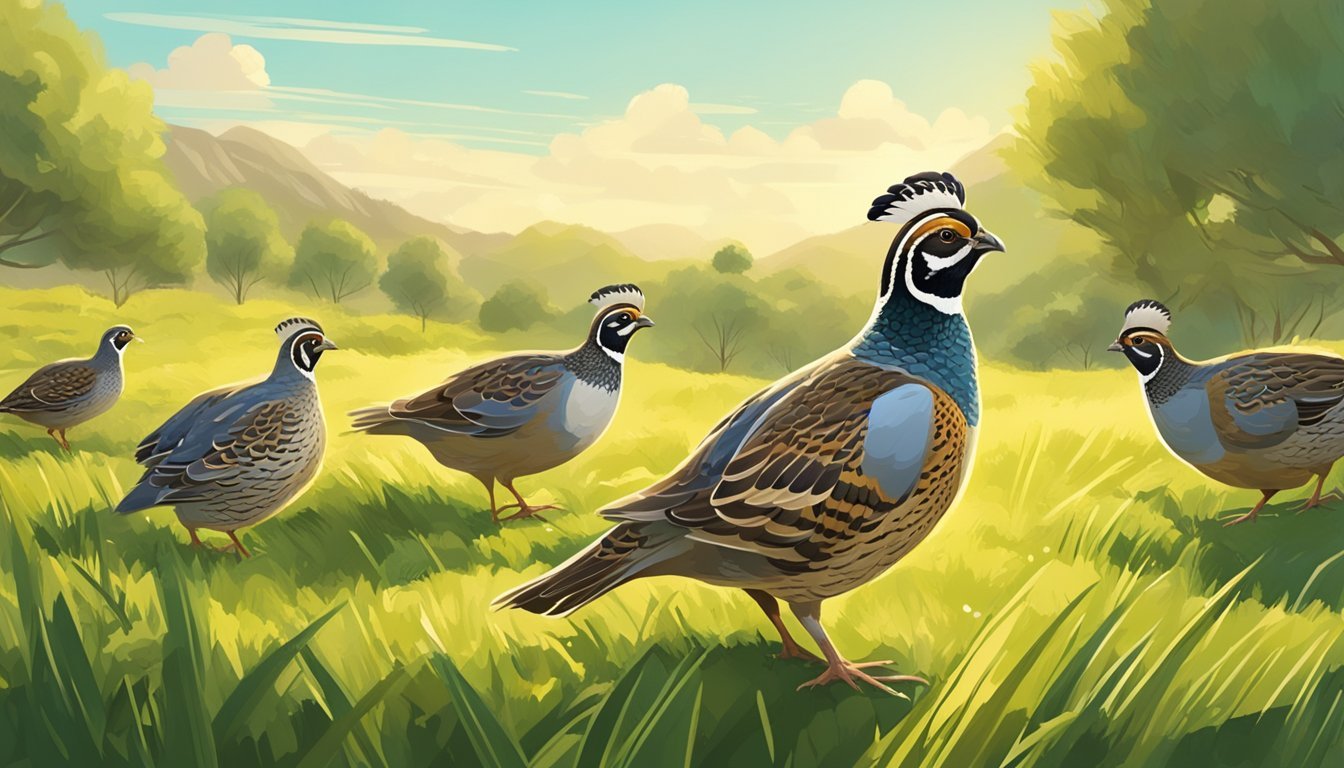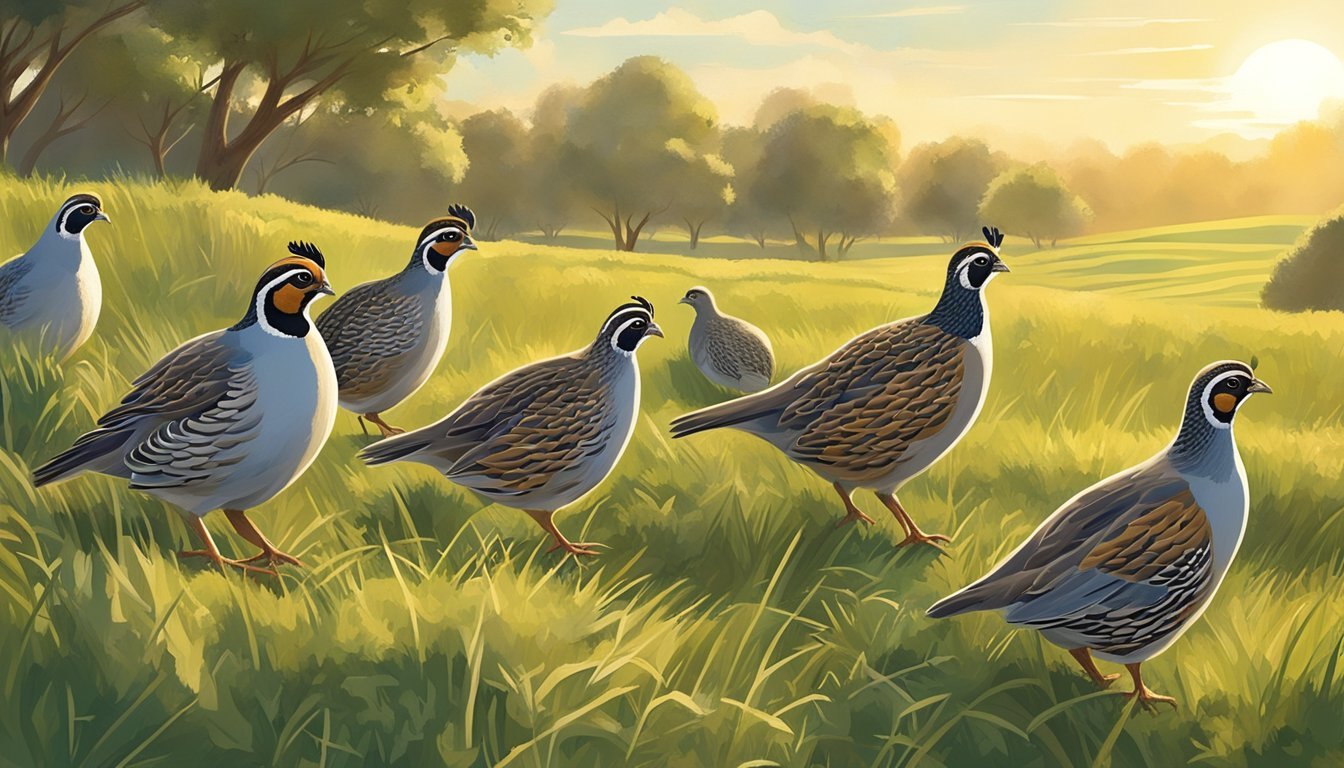Pasture Raised Quail
Benefits and Raising Practices
Raising pasture-raised quail (What wine goes well with quail?) is gaining popularity among small-scale farmers and backyard poultry enthusiasts. Unlike traditional methods, where quail is kept in confined cages, pasture raising allows these birds to roam freely in a protected environment. This farming practice not only simulates a more natural habitat for the quails but also provides them with access to a diverse diet, resulting from foraging on the ground. The method requires secure enclosures, often called quail tractors, to protect the birds from predators and prevent them from flying away, ensuring their safety while allowing them the benefits of outdoor living.
The benefits of pasture-raised quail are multifold. For one, quail that are raised on pasture tend to have a more varied diet, consisting of insects, seeds, and greens, which can lead to higher nutritional value in their meat and eggs compared to conventionally raised quail. Additionally, the lifestyle of pasture-raised quail often results in a leaner product with a more complex flavor profile. Furthermore, allowing quail to pasture helps to minimize the environmental impact of farming them, as they contribute to the land by naturally fertilizing it, reducing the need for artificial inputs.
Incorporating quail into a pasture-based system can also contribute to the overall sustainability of a farm. Diversification in farming operations with the addition of quail can provide an additional revenue stream alongside other livestock and agricultural ventures. As consumers become more conscious of animal welfare and sustainable practices, pasture-raised quail products can cater to a niche market looking for ethically sourced and environmentally friendly options. Thus, pasturing quail not only stands to benefit the health and welfare of the birds, but it also aligns with a more conscientious approach to farming that resonates with contemporary consumer values.
Pasture Raised Quail Fundamentals
When discussing pasture-raised quail, it's essential to understand the specifics of their environment, differences from other farming practices, and their origins to appreciate the practice fully.
Definition and Importance
Pasture-raised quail are birds that are kept in movable enclosures on grasslands, allowing them to forage naturally on grass and dirt, which is closer to their natural habitat. This method is important because it promotes animal welfare and can lead to healthier quail by providing a diet that includes natural forage, leading to higher nutritional quality of the eggs and meat they produce.
Historical Context
The practice of raising quail in pastures is not new but has gained renewed interest as part of the sustainable agriculture movement. Historically, quails were plentiful in their natural habitats and were hunted as game birds. Over time, the domestication and farming of specific quail breeds, such as the Coturnix quail, have adapted successfully to pasture environments, finding an equilibrium between traditional and modern farming methods.
Pasture Raised vs. Free Range
Pasture-raised and free-range systems have similarities but are distinct in practice. Pasture-raised systems usually involve:
Rotational grazing: Quail is moved regularly to fresh areas of grass and dirt.
Controlled exposure: Access to the outdoors is provided, yet it is in a predator-protected and managed space.
Conversely, free-range systems might allow the birds to roam more freely, often leading to less control over their diet and safety but more freedom of movement. In both systems, though, quail have access to the outdoors, which is in contrast to more constrained, traditional industrial farming methods.
Breeds and Species
Selecting the appropriate breed is crucial for successfully raising pasture-raised quail. Each breed offers unique characteristics that cater to different requirements such as meat production, egg laying, or suitability for release in game bird operations.
Coturnix Quail
The Coturnix quail, also known as the Japanese quail, is a hardy species preferred for its rapid growth and early maturity. They are prolific egg layers, with individuals capable of producing up to 300 eggs per year. Coturnix quail typically start laying at about 6 weeks of age and are also favored for their flavorful meat.
Key Attributes:
Egg Production: Up to 300 eggs annually
Maturity: Begins laying eggs at approximately 6 weeks
Meat Quality: Tender and flavorful
Bobwhite Quail
The Bobwhite quail is another popular choice, particularly in North America. They are known for their distinctive call and are often raised for hunting purposes. Bobwhite quails are larger than Coturnix and have a longer life span, living on average 2 to 4 years. Their meat and eggs are highly valued, though they mature more slowly than Coturnix quail.
Key Attributes:
Lifespan: 2 to 4 years
Maturity: Slower to mature than Coturnix
Usage: Often raised for hunting and sport
Game Bird Varieties
Different game bird varieties of quail are raised for sport and hunting. These birds are typically selected for their ability to thrive in a wild or semi-wild environment. The specific quail varieties chosen as game birds often depend on the region and the type of hunting experience desired. Species differences include variations in size, flight ability, and adaptability to natural habitats.
Common Traits of Game Birds:
Adaptability: Suited for semi-wild environments
Flight Ability: Strong flyers, suitable for hunting
Regional Preferences: Vary based on locality and hunter requirements
Housing and Environment
When raising quails, careful consideration must be given to their housing and environment for their well-being and productivity. Adequate shelter not only protects quails from predators but also ensures they can interact with their environment in a safe and natural manner.
Housing Requirements
Proper housing for quails must offer sufficient space and protection while allowing them access to natural ground cover. Their enclosures, commonly referred to as quail tractors, should be designed with sturdy frames and fine poultry netting to prevent escapes. Each quail should have at least one square foot of floor space. Ventilation is also critical to maintain air quality while avoiding drafts. The housing should include a roof to shelter the quails from harsh weather conditions and provide shade.
Protecting from Predators
Quails are vulnerable to predators such as foxes, raccoons, and birds of prey. Therefore, securing their habitat is essential. Enclosures must be enclosed on all sides, including the top, with robust materials like poultry netting to ensure they are predator proof. Consider burying the netting a few inches into the ground to deter digging predators. Regularly inspect the housing for any breaches and reinforce as needed.
Creating a Naturalistic Habitat
Quails thrive in an environment that mimics their habitat in the wild. Their enclosure should include areas of grass and soil for foraging and dust because they absolutely love dust bathing. Adding shrubs and plants provides cover and promotes a sense of security. Giving quails the freedom to roam and forage not only enhances their quality of life but can also contribute to the nutritional value of their eggs.
Nutrition and Diet; Custom-Formulated Corn
Providing a balanced diet is essential for raising quails. The right nutrition enhances the quality of quail eggs and supports the birds' overall health.
Pasture-raising does help eliminate the need to buy expensive bird seed mixes but they do require supplementation depending on the type of forage available. Rather than using store-bought feed one can custom-formulate for their birds and ensure a soy-free feed with the right mix for their needs at varying stages of life.
Pasture-raised quail should have access to a diet that closely mimics what they would find in a natural environment. This includes:
Seeds and Grains: Make up about 80% of the quail's diet. Preferred grains include white millet (how long does millet last?) and other commercially available grains formulated for game birds.
Proteins: Including insects, worms, and grubs, are crucial for growth and development, particularly for birds under 8 weeks old, chicks may require fishmeal added.
Vegetables: Such as carrots and green peppers, can be offered, ensuring they are cut into small, manageable pieces.
Daily Feeding Recommendation:
Approximately 3 tablespoons of feed per quail, with adjustments based on age, activity level, and production status (laying or growing).
Water is as crucial as food for quail. Key points include:
Constant Availability: Clean, fresh water should be accessible at all times.
Quality: Water containers must be kept clean to prevent disease.
Proper water access is non-negotiable for maintaining a healthy flock and ensuring optimal egg production.
Breeding and Reproduction
Successful breeding and reproduction in pasture-raised quail hinge on understanding the key factors that affect egg production, the roles of males and females, and the specific requirements for incubation and raising of chicks.
Incubation Process
When it comes to egg production, females are capable of laying a significant number of eggs within a breeding season, often beginning at 6-8 weeks of age.
The incubator setup is critical for hatching eggs. Humidity levels should be kept between 45-55% during incubation and increased to around 60-70% in the final days before hatching to ensure a higher hatch rate. Meanwhile, temperatures within the incubator must remain consistent, typically around 37.5°C (99.5°F).
Pre-incubation: Males and females should be well-fed and healthy to produce viable eggs.
During incubation: Regular turning of eggs is essential to prevent the embryo from sticking to the shell.
Post-incubation: After roughly 17-23 days, quail chicks will begin to hatch.
How To Raise Quail Chicks
Once the quail chicks emerge, it's vital to offer a stable environment that supports their rapid growth.
Temperature: Chicks require a brooder with a temperature of approximately 37.5°C (99.5°F) during their first week of life, which is then gradually decreased each week.
Nutrition: Quail chicks thrive on a starter feed that is high in protein, which is essential for their development in the first weeks of life.
Transition: As they grow, they can gradually be introduced to the same pasture environments as adults, with care to protect them from predators and extreme weather.
By monitoring the specifics of the breeding and incubation process and providing proper care for quail chicks, one can maintain a thriving population of pasture-raised quails.
Health and Care
Pasture-raised quail require attentive health management and routine care practices to ensure their well-being. Providing a habitat that mimics their natural environment contributes to their physical and mental health.
Nesting Box: Quails need a comfortable box to lay eggs. Nest boxes filled with soft hay or straw should be provided. The nesting area should be kept clean and dry to promote hygiene and prevent health issues.
Dust Baths: Dust baths are essential for quail health as they help control parasites and maintain feather condition. A shallow container filled with a mix of sand and diatomaceous earth can serve as a dust bath.
Drowning Prevention: Quail can drown in open water containers. To prevent this, use shallow water dishes and add pebbles or a marbles tray to ensure they can drink safely without the risk of drowning.
General Care: Ensure that quail enclosures are kept clean, as a dirty environment can quickly lead to disease. Regularly scan for signs of illness such as watery droppings or paleness and consult with a veterinarian swiftly to address any issues.
Commercial Aspects
The profitability of raising pasture-raised quail hinges on understanding market demand, processing logistics, and legal frameworks. A quail farming operation can be profitable with the sale of both meat and quail eggs, raising quails doesn't have too many overheads.
Market Demand and Economics
Market demand for pasture-raised quail is on the rise, driven by consumer interest in more sustainable and ethically produced animal products.
Quail meat is gaining popularity in upscale restaurants, particularly in states like California, where culinary trends often take root. This demand influences the price point, which can be higher for pasture-raised quail meat compared to conventionally raised quail due to the perceived quality and flavor profile.
Additionally, shipping costs and considerations - including live animal regulations - must be factored into the economic planning. Some businesses have turned to online platforms to market their products, offering shipping directly to consumers via mail.
Processing and Butchery
Processing pasture-raised quail requires meticulous attention to detail. After the slaughter, the birds are butchered, a service that can be handled in-house or outsourced to professional processors.
The process must comply with state and federal regulations which ensure the quail meat is safe for consumption. Smaller operations sometimes struggle with butchering due to the need for specialized skills and equipment, which can affect their profit margins.
It's essential to strike a balance between maintaining quality and managing costs effectively within this segment of the operation.
Preparation and Cooking and Consumption
Quail meat is acknowledged for its delicate flavor and tender texture, making it a sought-after game bird in culinary circles. Quail eggs, often used in various cuisines, are praised for their versatility and unique flavor profile.
Quail should be prepared with precision due to its size and delicate flesh. The bird is typically roasted or grilled to enhance its natural flavors. For oven cooking, a temperature of 375°F is ideal, with a cooking time of about 15 to 20 minutes, depending on the size of the bird. Here's a simple guide:
Preheat oven to 375°F.
Season the quail inside and out with desired spices.
Roast in the oven for 15-20 minutes.
Check for doneness; the internal temperature should reach 165°F.
Pasture-Raised Quail Eggs
Quail eggs are a staple in many culinary traditions, valued for their richness and slight gamey nuance compared to chicken eggs. Fresh quail eggs provide a burst of flavor when used raw in dishes such as sushi or salads.
They also can be pickled for a tangy snack or condiment. Chefs favor these tiny eggs for their ability to add elegance to a dish, often using them as a garnish due to their appealing size and shell coloration. Here's a brief overview of their use:
Raw: Topped on canapés such as steak tartare, or used in sushi for a burst of flavor.
Pickled: Brined in a vinegar mixture, often with spices, for a tangy treat.
Cooked: Boiled, fried, or poached, quail eggs are versatile and add a delightful touch to meals.





